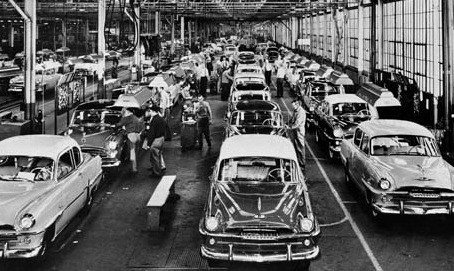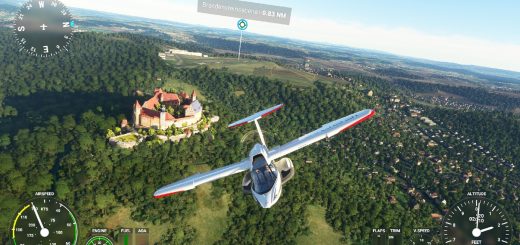Michiganderflyer-AutoTour v1.0
These files include POI for many of the Detroit Automotive locations, on top of the existing one of FCA world Headquarters Asobo included in the base sim. The only model included with this package is the Packard Proving grounds in Shelby Michigan. A Cessna 172 flightplan is included hitting most of the Waypoints and POI. Enjoy the history tour.
GM-World Headquarters ( 42°19’45.0″N 83°02’23.3″W ) The Renaissance Center (also known as the GM Renaissance Center and nicknamed the RenCen) is a group of seven connected skyscrapers in Downtown Detroit, Michigan, United States. The Renaissance Center complex is on the Detroit International Riverfront and is owned by General Motors as its world headquarters. The central tower, the Detroit Marriott at the Renaissance Center, is the third tallest all-hotel skyscraper in the Western Hemisphere.[8] It has been the tallest building in Michigan since it was erected in 1977.
FCA-Jeep Grand Cherokee Plant (42°22’50.8″N 83°02’46.8″W ) The facility was built in 1991 and produced the first Jeep Grand Cherokee in January 1992. In July 1999, the facility was expanded. Production of the 2005 Jeep Grand Cherokee launched in August 2004 and Jeep Commander production launched in July 2005. In May 2010, the all-new 2011 Jeep Grand Cherokee rolled off the line. A second shift of production began on July 19, 2010. The all-new 2011 Dodge Durango, the first Dodge ever to be produced at Jefferson North, began production on Dec. 14, 2010
Packard Proving Grounds ( 42°39’41.9″N 83°02’09.5″W ) An early attempt to locate a testing facility north and east of Detroit near the city of Mount Clemens was not approved by the Packard board of directors. A site had already been acquired by Henry Joy, but the 640 acres (2.6 km2) was deemed to not have enough topographic diversity to allow for such things as hill testing. At the dawn of America’s entry into World War I, Joy leased and eventually sold the site to the U.S. Government for use as a training airfield. The main access road to what was to become Selfridge Field was named Henry B. Joy Boulevard in honor of Joy.Almost eight years passed before a proving ground was again pursued. This time, a 560-acre (2.3 km2) site in Charter Township of Shelby, Michigan about 20 miles (32 km) due north of the Packard factory, was procured. Noted Detroit architect Albert Kahn was retained to design the buildings of the facility, which was opened in 1928.[2]
Packard Assembly Plant ( 42°22’47.7″N 83°01’43.5″W ) The 3,500,000-square-foot (325,000 m2), designed by Albert Kahn Associates using Trussed Concrete Steel Company products is located on 40 acres (16 ha) of land on East Grand Boulevard on the city’s east side. It included the first use of reinforced concrete in the United States for industrial construction in the automobile industry.[1][2][3][4][5]
The Packard plant was opened in 1903 and at the time was considered the most modern automobile manufacturing facility in the world: modern, efficient, and massive in scale. At its peak the complex employed 40,000 people, including skilled craftsmen involved in over eighty trades. The plant turned out Packard automobiles from 1903 to 1956, except during World War II, when production was shifted to war material, particularly the Packard V-1650 Merlin, which powered the North American P-51 Mustang fighter plane.[6]
Ford-Romeo Proving Grounds ( 42°50’59.6″N 83°03’53.3″W ) The Ford Michigan Proving Ground (MPG) of Romeo, Michigan sits on 3,880 acres (15.7 km²), and contains a total of over 100 miles (160 km) of roads. These grounds hold events like the Society of Automotive Engineers (SAE) Formula car competition (FSAE). This involves teams from colleges and universities around the world to compete in a competition involving both design and performance.
Major facilities: High speed track, durability/special surface roads, grades, EMC facility, road simulators, fire resistance facility, vehicle dynamics areaPurpose: Car and truck durability, performance testing
GM-Milford Proving Grounds ( 42°35’23.5″N 83°40’44.7″W ) The General Motors Milford Proving Ground was the industry’s first dedicated automobile testing facility when it opened in 1924. It is located in Milford, Michigan and covers 4,000 acres (1,600 ha). 4,800 staff work in its 142 buildings today. The proving ground includes the equivalent of 132 miles (212 km) of roads representative of conditions found on public roadways and other specialty surfaces for vehicle testing. Some roads are open only to drivers who have passed special performance driving training. The saying goes that each mile driven on the grounds is the same as 5 miles (8.0 km) in the real world.
FCA-Chelsea Proving Grounds ( 42°16’24.6″N 84°03’14.2″W ) Details about the facility:
The facility covers an area of 3,850 acres (15.6 km2)Sled-impact testing siteCovered crash barrierSkid traction areaMileage accumulatorsEmissions certification CenterWind tunnelCorrosion testing facilityCurb hit testing32% grade and 15% gradeNew “spaghetti” road being constructed
Old Studebaker Engineering ( 42°22’28.1″N 83°11’04.0″W ) Detroit is known for some abandoned buildings that had to have been quite remarkable in their heyday. One day after work I figured I’d stop by the old AMC headquarters. Well, that’s what it was called near the end of it’s life, but it started out as the headquarters and manufacturing plant for a refrigerator company called Kelvinator in 1927. That company joined with Nash and began manufacturing automobiles (the Nash Rambler) in the three story manufacturing plant in 1937.Then an AMC Engineering facility, and Chrusler Jeep and truck Engineering until sold by a private company and stripped for salvage.
Ford-Model T Plant ( 42°24’34.0″N 83°05’38.7″W ) The Highland Park Ford Plant was designed by Albert Kahn Associates in 1908 and was opened in 1910. Ford automotive production had previously taken place at the Ford Piquette Avenue Plant, where the first Model Ts were built. The Highland Park Ford Plant was approximately 4 miles (6.4 km) northwest of the original Dodge Brothers factory who were subcontractors for Ford, producing precision engine and chassis components for the Model T. It was also approximately 1 mile (1.6 km) northwest of the former Brush-Maxwell plant, which later became the headquarters for the Chrysler Corporation
GM-Technical Center ( 42°30’57.5″N 83°02’08.8″W ) The GM Technical Center is a General Motors facility in Warren, Michigan. The campus has been the center of the company’s engineering effort since its inauguration in 1956. In 2000 it was listed on the National Register of Historic Places; fourteen years later it was designated a National Historic Landmark, primarily for its architecture.[2]
FCA-Windsor Minivan Plant ( 42°17’37.4″N 82°59’04.3″W ) The plant was designed by the architectural firm Hutton & Souter.[3] It covers 408,773 square metres (4.4 million sq. ft.)[4] on 50 hectares (123.3 acres) and manufactured the Generation I Dodge Caravan and Plymouth Voyager minivans from 1983 until 1991. The Generation II minivans, constructed on the AS platform was equipped with an optional V6 engine and in a new long wheel-base version. The Generation III (NS) minivan production began in 1995 — with dual sliding doors. Starting in July 2000, the Generation IV (RS) minivan, which included the Stow’n Go seating, was produced until July 2007. In August 2007, the Generation V (RT) minivan was introduced which continues with the Stow ‘n Go and features the new Swivel’n Go seating. The current Chrysler Pacifica (RU) minivan, that replaced the Chrysler Town & Country, entered production in 2016 for the 2017 model year and includes both gasoline engine and plug-in hybrid versions.
Ford- F150 Plant ( 42°18’09.4″N 83°09’56.3″W )






